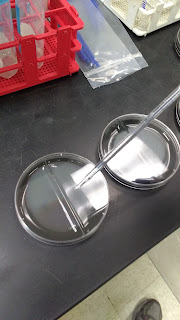In the following post, I actually am doing both methods simultaneously because one client is from not New York, and one client is from New York. Many of the steps are similar. Here we go!
Here is nearly everything I need to test for both methods of Legionella. From left to right: vacuum pump, 100ml sterilized tips, pipetter, erlenmeyer flask with rubber fitting, vortexer, sharpie, chlorine test strips, samples, skinny tubes, glass tubes, black agar plates, blue large tubes, Page's Saline, saline, NY acid, Legionella acid, cultures of Pseudomonas aeruginosa and Legionella pneumoniae, sterile water, 2um disposable filters.
Not pictured: 1 ml glass pipettes, pipette bulb, forceps, ethanol, lighter
First step, required for NY, optional for CDC. Test the chlorine content of the water.
Good result! You can proceed with testing of the sample.
BAD RESULT.
Add sodium thiosulfate until result is good. In this case it was 100 ml of sample, so I added 100 ul at a time.
Fill large tubes with 10 ml of saline (Pages for NY, general for CDC)
Filter 100 ml of sample.
Dip the forceps into ethanol and SET THEM ON FIRE! (to sterilize) Once cool, use the forceps to transfer the filter paper to the blue eppendorf tubes.
VORTEX! Just... generally for CDC, for 2 VERY LONG MINUTES for NY.
Yay!
Forceps and ethanol
For NY, you have to run positive and negative controls. Using the McFarland standards, you can guesstimate your concentration of bacteria in liquid by comparing the cloudiness. Pseudomonas is the negative control, Legionella is duh, the positive.
To save time, vortex multiple tubes at once and cut vortexing time in half!
CDC: Use bi plates with two similar agars on each side. Pipette 0.1 ml onto each side.
Spread that sample around. You can use the same spread from side 1 to 2, but not 2 to 1 and obviously not from one sample to the next.
NY samples go on a single type of agar (Side 2 but poured onto a whole plate). You plate 0.5 ml and spread.
NY also has a 30 minute 50deg C heat treatment.
Each treatment also gets plated onto it's own plate.
In the end, CDC method uses 4 plates (regular and 3 acid) per sample, NY uses 3 plates per sample (regular, heat, acid) plus the controls.
All of those plates go into anaerobic jars. You light the candle and tighten the lid, the candle burns all the oxygen. Those jars get incubated for 5 days (CDC) or up to 10 days (NY) at 35 deg C.
How we identify legionella coming up next!
BONUS SCIENCE
A picture of the product my company manufactures. It's a two sided dip stick. You dip it in a limited volume of water and bacteria or fungi stick to the agar. You can enumerate how much bacteria is in your volume of water.



















No comments:
Post a Comment